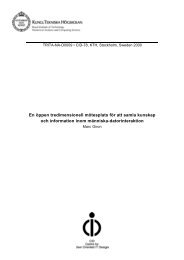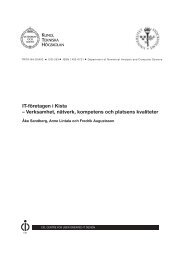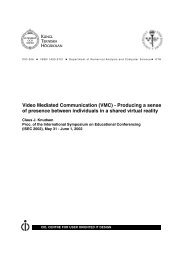HCI education in Sweden - CID - KTH
HCI education in Sweden - CID - KTH
HCI education in Sweden - CID - KTH
You also want an ePaper? Increase the reach of your titles
YUMPU automatically turns print PDFs into web optimized ePapers that Google loves.
<strong>HCI</strong> <strong>education</strong> <strong>in</strong> <strong>Sweden</strong><br />
Lars Oestreicher and Jan Gulliksen<br />
<strong>CID</strong>-100, <strong>KTH</strong>, Stockholm, <strong>Sweden</strong> 2000
<strong>HCI</strong> <strong>education</strong> <strong>in</strong> <strong>Sweden</strong><br />
Lars Oestreicher and Jan Gulliksen<br />
<strong>CID</strong>-100, <strong>KTH</strong>, Stockholm, <strong>Sweden</strong> 2000
Lars Oestreicher and Jan Gulliksen<br />
<strong>HCI</strong> <strong>education</strong> <strong>in</strong> <strong>Sweden</strong><br />
Report number: <strong>CID</strong>-100<br />
ISSN number: ISSN 1403-0721 (pr<strong>in</strong>t) 1403-073X (Web/PDF)<br />
Publication date: January 2000<br />
E-mail of author: Larsoe@dis.uu.se, Jan.Gulliksen@hci.uu.se<br />
URL of author: http://cid.nada.kth.se<br />
Reports can be ordered from:<br />
<strong>CID</strong>, Centre for User Oriented IT Design<br />
NADA, Deptartment of Numerical Analysis and Computer Science<br />
<strong>KTH</strong> (Royal Institute of Technology)<br />
SE-100 44 Stockhom, <strong>Sweden</strong><br />
Telephone: + 46 (0)8 790 91 00<br />
Fax: + 46 (0)8 790 90 99<br />
E-mail: cid@nada.kth.se<br />
URL: http://cid.nada.kth.se
Jan Gulliksen & Lars Oestreicher<br />
<strong>HCI</strong> is still a rather new<br />
subject for Scand<strong>in</strong>avian<br />
undergraduate level<br />
studies. Ten years ago<br />
only short courses at various<br />
computer science<br />
and system development<br />
<strong>education</strong>s were available.<br />
Dur<strong>in</strong>g the last<br />
two-three years <strong>HCI</strong><br />
<strong>education</strong> has grown<br />
rather rapidly through<br />
the establishment of<br />
m<strong>in</strong>or programs at the<br />
smaller universities and<br />
with specific profiles at<br />
the bigger universities.<br />
In 1998 the first Ph.D. <strong>in</strong><br />
<strong>HCI</strong> graduated and now<br />
an HMI graduate school<br />
has been started <strong>in</strong><br />
L<strong>in</strong>köp<strong>in</strong>g and Stockholm.<br />
<strong>HCI</strong> has also been<br />
well established as a<br />
research activity <strong>in</strong> <strong>Sweden</strong><br />
and is now becom<strong>in</strong>g<br />
more and more regular<br />
departments at the major universities.<br />
Still, <strong>education</strong> <strong>in</strong> <strong>HCI</strong> is varied <strong>in</strong><br />
content and direction, and this paper<br />
describes a first Swedish workshop<br />
aimed at review<strong>in</strong>g the contents of<br />
<strong>HCI</strong> courses <strong>in</strong> <strong>Sweden</strong>.<br />
Education<br />
Proposed Discussion Topics<br />
The workshop was <strong>in</strong>itiated through a<br />
session where everybody was asked<br />
about their expectation on the workshop<br />
<strong>in</strong> the forms of relevant questions<br />
to discuss. The <strong>in</strong>itial questions and<br />
discussion topics were, <strong>in</strong> order of<br />
appearance:<br />
1. How do you create a balance<br />
between redesign<strong>in</strong>g exist<strong>in</strong>g artifacts<br />
and promot<strong>in</strong>g new and creative<br />
solutions?<br />
2. Exchange experiences concern<strong>in</strong>g<br />
different pedagogical approaches to<br />
<strong>HCI</strong><br />
3. New ways of exam<strong>in</strong><strong>in</strong>g <strong>HCI</strong><br />
<strong>HCI</strong> Education <strong>in</strong> <strong>Sweden</strong><br />
Reports from a national workshop on <strong>HCI</strong> <strong>education</strong><br />
courses<br />
4. What should a basic <strong>HCI</strong> course<br />
conta<strong>in</strong>?<br />
5. What should advanced <strong>HCI</strong> courses<br />
conta<strong>in</strong>?<br />
6. What basic knowledge should we<br />
require?<br />
7. How can we <strong>in</strong>troduce practical<br />
tasks <strong>in</strong>to a <strong>HCI</strong> course?<br />
Without it tak<strong>in</strong>g too much of the<br />
time?<br />
Us<strong>in</strong>g simple and realistic problems?<br />
8. How do you create motivation for<br />
the students to take <strong>HCI</strong> as a secondary<br />
subject?<br />
9. Practical issues<br />
How do we teach <strong>in</strong>novation?<br />
How do we teach creativity?<br />
10.What can we learn from the game<br />
<strong>in</strong>dustry?<br />
We did not go through the questions <strong>in</strong><br />
detail but touched upon most of them<br />
<strong>in</strong> the discussion that followed.<br />
Basic <strong>HCI</strong> Courses<br />
Through a bra<strong>in</strong>storm<strong>in</strong>g session we<br />
attempted to condense a set of what we<br />
considered to be typical knowledge<br />
that a basic course on <strong>HCI</strong> should<br />
present.<br />
We performed an <strong>in</strong>formal survey <strong>in</strong><br />
which the workshop participants were<br />
to choose the five most important subjects<br />
and the summary of the votes<br />
went as shown <strong>in</strong> Table 1. The course<br />
should comprise 5 po<strong>in</strong>ts (where 1<br />
po<strong>in</strong>t corresponds to approximately<br />
one week of work). The number of<br />
subjects turned out to be rather limited.<br />
This <strong>in</strong>formal survey <strong>in</strong>dicates that<br />
cognitive psychology, design pr<strong>in</strong>ciples/processes,<br />
<strong>in</strong>teraction techniques,<br />
usability, task analysis, evaluation<br />
methods, system development methods<br />
and prototyp<strong>in</strong>g could be regarded<br />
as the most important themes <strong>in</strong> a<br />
basic <strong>HCI</strong> course. In the discussions<br />
that followed, there was a general<br />
agreement that it might be dangerous<br />
to go <strong>in</strong>to too much of detail on each of<br />
the separate topics and that the <strong>education</strong><br />
should rather be guided towards<br />
look<strong>in</strong>g at IT solutions as a whole.<br />
Table 1: The various subjects proposed for an<br />
<strong>in</strong>troductory course on <strong>HCI</strong><br />
Subject<br />
Vote<br />
Design pr<strong>in</strong>ciples/process 10<br />
Cognitive psychology 10<br />
Interaction techniques 9<br />
Usability 7<br />
Task analysis 7<br />
Evaluation methods 6<br />
System development methods 6<br />
Prototyp<strong>in</strong>g 5<br />
Information visualization 3<br />
New techniques 3<br />
Interface stuff 2<br />
CSCW 2<br />
Method 2<br />
<strong>HCI</strong> as a responsibility for programmers/developers<br />
2<br />
Web design 1<br />
Design for all 1<br />
Interdiscipl<strong>in</strong>ary 1<br />
Emotion 1<br />
Interaction pr<strong>in</strong>ciples —<br />
Hypertext —<br />
L<strong>in</strong>guistics —<br />
Real time systems —<br />
Graphical design —<br />
Complex systems —<br />
Social & organizational aspects —<br />
Ethics —<br />
Supplementary <strong>HCI</strong> Courses<br />
We cont<strong>in</strong>ued the session by look<strong>in</strong>g<br />
at a set of potential supplementary<br />
courses which might be given to students<br />
(all based on 5 po<strong>in</strong>t course<br />
blocks). The idea was to f<strong>in</strong>d course<br />
topics that would be:<br />
1. Sufficient to form courses on their<br />
own<br />
2. Central enough to defend their roles<br />
4 April 1999 Volume 31, Number 2 SIGCHI Bullet<strong>in</strong>
as separate courses<br />
Although some of the suggested<br />
courses might be a bit too small or narrow<br />
<strong>in</strong> their focus, one conclusion of<br />
this <strong>in</strong>formal survey is that there is a<br />
large set of possible and potentially<br />
<strong>in</strong>terest<strong>in</strong>g course topics for a devoted<br />
<strong>HCI</strong> student (or teacher).<br />
• Method, Evaluation methods and<br />
usability<br />
• Design<br />
• Functional design<br />
• Screen presentation<br />
• Cognitive design?<br />
• Graphical design<br />
• Prototyp<strong>in</strong>g & user centered design<br />
• Creativity & Innovation<br />
• Multimedia and multi-modality<br />
• Tools for UI design & Programm<strong>in</strong>g<br />
• Social, moral and organizational<br />
aspects/effects of IT<br />
• Documentation and supervision<br />
• Pedagogical user <strong>in</strong>terfaces<br />
• “Theoretical views”<br />
• Project adm<strong>in</strong>istration, Co-operation<br />
This list of possible topics has not<br />
been ordered <strong>in</strong> any way. Some of<br />
these topics are overlapp<strong>in</strong>g, e.g.,<br />
graphic design and screen design.<br />
However, the discussions also showed<br />
that the participants of the workshop<br />
did not <strong>in</strong>terpret some of the course<br />
titles <strong>in</strong> the same way. It is thus very<br />
likely that different teachers will give<br />
the topics slightly different focus,<br />
depend<strong>in</strong>g on personal preferences.<br />
Course Literature<br />
Dur<strong>in</strong>g the discussion on <strong>HCI</strong> courses,<br />
the issue of textbooks was raised. One<br />
<strong>in</strong>itial observation is that the selection<br />
of central textbooks actually used on<br />
courses was relatively small (e.g.,<br />
Preece et al. 1994, and Dix et al.<br />
1998). Surpris<strong>in</strong>gly, it seemed that the<br />
participants were not directly satisfied<br />
with the books. The lack of a good<br />
Swedish book was also mentioned.<br />
The problem of select<strong>in</strong>g textbooks<br />
and reference literature seems to be a<br />
problem <strong>in</strong> many <strong>HCI</strong> <strong>education</strong>s.<br />
Also, whereas the basic books, as<br />
mentioned above, are at least potentially<br />
useful, there are very few books<br />
that can be applied on higher levels of<br />
<strong>education</strong>.<br />
When asked for books that had been<br />
used <strong>in</strong> courses (at some po<strong>in</strong>t), the<br />
participants of the workshop collectively<br />
mentioned some 5 to 10 books,<br />
which were used for the basic <strong>education</strong><br />
<strong>in</strong> <strong>HCI</strong>.<br />
The general critique on the books was<br />
that they generally:<br />
• are too shallow <strong>in</strong> the coverage of<br />
many topics<br />
• impose a common structure on <strong>HCI</strong>,<br />
which is not necessarily the best<br />
from a pedagogical po<strong>in</strong>t of view<br />
• try to cover too many topics with<strong>in</strong><br />
what is reasonable <strong>in</strong> 5 weeks<br />
The general view was that if, for<br />
example, a more problem-oriented<br />
<strong>education</strong>al approach would be<br />
adopted on the course there is no really<br />
useful textbook on the market.<br />
New Forms of Education<br />
S<strong>in</strong>ce some of the issues mentioned<br />
new ways of teach<strong>in</strong>g and exam<strong>in</strong><strong>in</strong>g<br />
<strong>HCI</strong>, a discussion grew <strong>in</strong> outbreak<br />
sessions about how new forms of <strong>HCI</strong><br />
<strong>education</strong> could be developed. S<strong>in</strong>ce<br />
these discussions were spontaneous<br />
and unstructured, only a very small<br />
selection of the subjects covered is<br />
mentioned here.<br />
One po<strong>in</strong>t that was made several times<br />
was the size of the <strong>education</strong>al groups<br />
(The participants reported experiences<br />
from 6-175 students). Generally a<br />
smaller number of students per group<br />
promotes better results, as well as a<br />
larger possibility to discuss <strong>in</strong>terest<strong>in</strong>g<br />
aspects of <strong>HCI</strong>. On the other hand,<br />
larger groups of students could be handled<br />
<strong>in</strong> project teams where comparative<br />
design solutions could be one way<br />
of develop<strong>in</strong>g the students’ awareness<br />
of alternative design solutions.<br />
It was also considered beneficial to<br />
develop new forms for exam<strong>in</strong>ation.<br />
The problem is to exam<strong>in</strong>e the student<br />
<strong>in</strong> a more holistic way, not focuss<strong>in</strong>g<br />
on details. A start<strong>in</strong>g po<strong>in</strong>t for the discussions<br />
was some experiments performed<br />
at Chalmers Institute of<br />
Technology <strong>in</strong> Gothenburg. The<br />
exam<strong>in</strong>ation was performed as an oral<br />
exam<strong>in</strong>ation on previously submitted<br />
mandatory tasks. By us<strong>in</strong>g this type of<br />
exam<strong>in</strong>ation the throughput and the<br />
frequency of exam<strong>in</strong>ation <strong>in</strong> the organization<br />
<strong>in</strong>creased substantially. In<br />
this case, it was also possible to let the<br />
students perform projects that lasted<br />
up to a year. One example assignment<br />
of this k<strong>in</strong>d was to develop a system<br />
for handl<strong>in</strong>g medical records for gymnastic<br />
therapists.<br />
As a related topic the use of problem<br />
based <strong>education</strong> <strong>in</strong> <strong>HCI</strong> was discussed<br />
<strong>in</strong> fairly large detail. This discussion<br />
also raised the question on lectur<strong>in</strong>g<br />
versus supervis<strong>in</strong>g. S<strong>in</strong>ce <strong>HCI</strong> is an<br />
area, to a large extent, based on understand<strong>in</strong>g<br />
rather than actually learn<strong>in</strong>g<br />
of details, it was considered <strong>in</strong>terest<strong>in</strong>g<br />
to <strong>in</strong>crease the focus on supervis<strong>in</strong>g<br />
assignments, rather than us<strong>in</strong>g traditional<br />
lectur<strong>in</strong>g <strong>in</strong> <strong>HCI</strong> <strong>education</strong>. This<br />
can probably not be used as a general<br />
assumption, but it can be applied at<br />
least partially <strong>in</strong> most classes.<br />
A fairly <strong>in</strong>tense debate on textbooks<br />
and their quality also promoted one<br />
suggestion concern<strong>in</strong>g course literature,<br />
namely to let the students themselves<br />
f<strong>in</strong>d, analyze and use the<br />
various and often contradictory guidel<strong>in</strong>es<br />
that can be found on the web as<br />
part of the course literature. The general<br />
idea <strong>in</strong> these discussions was to<br />
<strong>in</strong>crease the students’ awareness of<br />
that there are no simple solutions to<br />
<strong>HCI</strong> problems. One problem with textbooks<br />
is that the students tend to<br />
regard them as the “solution” to all<br />
their problems.<br />
Freedom <strong>in</strong> the choice of mandatory<br />
tasks also made a difference <strong>in</strong> the student’s<br />
motivation. The treatment of<br />
real or realistic problems is advantageous,<br />
such as computerization of bus<br />
stops or support for people with special<br />
needs, especially people with<br />
severe disabilities (à la Stephen Hawk<strong>in</strong>g).<br />
Real user participation is also beneficiary.<br />
However, lett<strong>in</strong>g the students<br />
use real companies or users for their<br />
course assignments was by some of<br />
the participants considered a problem.<br />
However, at Chalmers the students<br />
were often asked to visit companies<br />
for their assignments and apparently<br />
they seemed to get a rather large number<br />
of supportive companies.<br />
SIGCHI Bullet<strong>in</strong> Volume 31, Number 2 April 1999 5
Industrial Requirements on <strong>HCI</strong><br />
Education<br />
One special concern <strong>in</strong> <strong>HCI</strong> <strong>education</strong><br />
is the promotion of <strong>HCI</strong> <strong>in</strong> the <strong>in</strong>dustry.<br />
One of the participants has practiced<br />
<strong>HCI</strong> <strong>education</strong> for <strong>in</strong>dustry for<br />
several years. In this chapter his ma<strong>in</strong><br />
po<strong>in</strong>ts of view are summarized. <strong>HCI</strong><br />
<strong>education</strong> is becom<strong>in</strong>g <strong>in</strong>creas<strong>in</strong>gly<br />
important also from the companies’<br />
perspective. There is clearly a greater<br />
need for <strong>HCI</strong> experts than to promote<br />
usability <strong>in</strong>creas<strong>in</strong>g operations<br />
through methods and tools. Although<br />
this is also important as an expert evaluation<br />
of a user <strong>in</strong>terface is always<br />
more worthwhile when it comes to<br />
time and resources. The <strong>in</strong>dustry is<br />
also pragmatic. One can never achieve<br />
a perfect result, one should rather<br />
strive to achieve as good as possible<br />
with<strong>in</strong> the available time. What the<br />
<strong>in</strong>dustry needs is both pragmatic<br />
knowledge and hands-on advice and<br />
guidel<strong>in</strong>es. Therefore it is often better<br />
to do little than to do much (and never<br />
get anyth<strong>in</strong>g done).<br />
An important th<strong>in</strong>g for <strong>HCI</strong> <strong>education</strong><br />
is to tra<strong>in</strong> peoples ability to be sensitive<br />
for judg<strong>in</strong>g good and bad design,<br />
an ability that partly is there by heart<br />
and partly can be tra<strong>in</strong>ed. This could<br />
possibly be performed based on realistic<br />
problems and then apply<strong>in</strong>g <strong>HCI</strong><br />
knowledge to be able to achieve better<br />
design. A practical design course<br />
could, for example, use Don Norman’s<br />
book (The design of everyday th<strong>in</strong>gs)<br />
and let the students apply the ideas <strong>in</strong><br />
it to <strong>HCI</strong>.<br />
<strong>HCI</strong> is best applied through “<strong>in</strong>doctr<strong>in</strong>ation”<br />
<strong>in</strong>to projects, simply by show<strong>in</strong>g<br />
that someth<strong>in</strong>g works by apply<strong>in</strong>g<br />
it. “Learn<strong>in</strong>g on the job”, to work with<br />
your skills and expertise is important<br />
<strong>in</strong> <strong>education</strong>. Work<strong>in</strong>g <strong>in</strong> projects is<br />
one of the best ways to learn. Extra<br />
credibility can for <strong>in</strong>stance be<br />
achieved by <strong>in</strong>vit<strong>in</strong>g guest lecturers<br />
from companies that tell the “right”<br />
th<strong>in</strong>gs. Usability should be a major<br />
goal <strong>in</strong> all development with<strong>in</strong> a company,<br />
rather than be<strong>in</strong>g a goal to evaluate<br />
aga<strong>in</strong>st <strong>in</strong> the end. Usability is not<br />
someth<strong>in</strong>g that can be applied <strong>in</strong> the<br />
end.<br />
Sunsh<strong>in</strong>e or disaster histories are useful<br />
<strong>in</strong> <strong>HCI</strong> <strong>education</strong> but difficult to<br />
acquire from the <strong>in</strong>dustry. There are<br />
many reasons for this:<br />
• It can be difficult to actually tell<br />
whether a project has succeeded or<br />
failed.<br />
• Evaluation is often performed by<br />
other than those who have done the<br />
work.<br />
• The <strong>in</strong>dustry does not want to get an<br />
image of a company that failed or<br />
shared a w<strong>in</strong>n<strong>in</strong>g concept.<br />
The requirement specification is a central<br />
concept not only <strong>in</strong> software eng<strong>in</strong>eer<strong>in</strong>g/design<br />
but also <strong>in</strong> <strong>HCI</strong> design,<br />
and requirements gather<strong>in</strong>g is thus a<br />
central part <strong>in</strong> <strong>HCI</strong> work. The responsibility<br />
for arriv<strong>in</strong>g at a solution should<br />
never be put on the user; it is up to the<br />
system developer to design a good<br />
product. Alternative solutions should<br />
be used to promote new ways of do<strong>in</strong>g<br />
old tasks. It is unfortunately far too<br />
easy to be stuck <strong>in</strong> your old trails.<br />
A good example of a small practical<br />
design task is to ask the students to<br />
design functional salt and pepper<br />
packages for airl<strong>in</strong>e passengers. You<br />
can arrive at several conceptual design<br />
solutions with<strong>in</strong> 15 m<strong>in</strong>utes and discuss<strong>in</strong>g<br />
the different design solutions<br />
is a good practical way to do parallel<br />
design. It is very useful for students to<br />
discuss each other’s ideas. People<br />
could arrive at very different design<br />
solutions reflect<strong>in</strong>g the exist<strong>in</strong>g design<br />
space, e.g., color-cod<strong>in</strong>g, different<br />
granularity, transparent packages.<br />
Tra<strong>in</strong><strong>in</strong>g the student’s ability to figure<br />
around everyday designs and their<br />
benefits and drawbacks is useful. Why<br />
can the specification of what is on the<br />
different floors only be read outside<br />
the elevator?<br />
How can one teach or learn <strong>in</strong>novation?<br />
Is it even possible? Bra<strong>in</strong>storm<strong>in</strong>g<br />
sessions can be very useful to be<br />
able to achieve creativity. Observation<br />
is very useful to learn benefits/drawbacks<br />
with different design solutions.<br />
Show<strong>in</strong>g system developers how the<br />
users actually used the system repeatedly<br />
actually made them understand<br />
and want to correct their designs rather<br />
than address<strong>in</strong>g an evaluation report.<br />
The people that today are educated <strong>in</strong><br />
<strong>HCI</strong> so far seem to have turned up as<br />
teachers, due to the heavy <strong>in</strong>crease <strong>in</strong><br />
the subject. Those who at last reach the<br />
market usually ends up as consultants.<br />
There is a need for <strong>HCI</strong> <strong>education</strong> for<br />
people who f<strong>in</strong>ally end up <strong>in</strong> supervisory<br />
or strategic decision mak<strong>in</strong>g situations.<br />
People who study law,<br />
economics and bus<strong>in</strong>ess applications<br />
might eventually end up <strong>in</strong> supervisory<br />
positions <strong>in</strong> a company.<br />
We must promote an <strong>in</strong>crease <strong>in</strong> <strong>HCI</strong><br />
<strong>education</strong> at all levels. An English survey<br />
concluded that 6% of the Englishmen<br />
physically abuse their computers<br />
and 2/3 of the Englishmen do not<br />
know how to program their VCR.<br />
Discussion<br />
Prior to the workshop an <strong>in</strong>formal survey<br />
was performed <strong>in</strong> “ASKEN” the<br />
web service that support Swedish students<br />
with search possibilities on<br />
courses and <strong>education</strong> programs that<br />
exist <strong>in</strong> <strong>Sweden</strong>. This survey shows<br />
that a large number and a great variety<br />
of different courses are offered today,<br />
many of them not at all known by the<br />
participants. You could take <strong>HCI</strong> for 3<br />
weeks or for one year. <strong>HCI</strong> courses<br />
were hidden underneath non-descriptive<br />
names and <strong>in</strong> comb<strong>in</strong>ation with<br />
very many different courses. Evidently<br />
there is a need for a Scand<strong>in</strong>avian<br />
curriculum for <strong>HCI</strong> <strong>education</strong>.<br />
In addition to this, if you analyze job<br />
open<strong>in</strong>gs <strong>in</strong> the newspaper you’ll see<br />
that <strong>HCI</strong> experts are sought under<br />
titles, such as usability managers,<br />
human factors specialists, IT-strategist,<br />
ergonomist, etc., lack<strong>in</strong>g a commonly<br />
understood concept for the role<br />
needed. A commonly agreed <strong>HCI</strong> <strong>education</strong><br />
curriculum could make it much<br />
easier to market the subject of <strong>HCI</strong> to<br />
the <strong>in</strong>dustry.<br />
Conclusions<br />
This workshop concluded that there is<br />
a need for (among many other th<strong>in</strong>gs):<br />
• a more thorough survey on the<br />
courses taught at the universities <strong>in</strong><br />
<strong>Sweden</strong>.<br />
• a forum for exchang<strong>in</strong>g <strong>education</strong>al<br />
ideas <strong>in</strong> <strong>Sweden</strong>.<br />
6 April 1999 Volume 31, Number 2 SIGCHI Bullet<strong>in</strong>
• an <strong>education</strong>al data bank where <strong>education</strong>al<br />
material, tips and text book<br />
evaluations can be found.<br />
On the other hand, we all also received<br />
several ideas and tips on how to focus<br />
and plan the com<strong>in</strong>g <strong>education</strong>al<br />
events. One <strong>in</strong>terest<strong>in</strong>g possibility<br />
would be to try to establish some k<strong>in</strong>d<br />
of a lecturer’s network. This network<br />
could, <strong>in</strong> the longer perspective, serve<br />
several purposes:<br />
• to be supportive <strong>in</strong> need of <strong>in</strong>spiration<br />
• to be a source of guest lecturers<br />
• offer mentor-ship for new teachers<br />
Still this is to be developed <strong>in</strong> a moderate<br />
pace so that the effort is not too<br />
large. One risk is that too much is<br />
started at the same time, which will not<br />
be beneficial. A pr<strong>in</strong>cipal issue to<br />
resolve <strong>in</strong> com<strong>in</strong>g workshops would<br />
be how to proceed the work that has<br />
started with this workshop, and to lay<br />
some <strong>in</strong>itial foundations for an <strong>education</strong>al<br />
network.<br />
Acknowledgments<br />
The workshop participants are all<br />
acknowledged for their <strong>in</strong>put on the<br />
workshop. STIMDI and the University<br />
of Umeå are acknowledged for host<strong>in</strong>g<br />
the workshop.<br />
About the Authors<br />
Jan Gulliksen, Ph.D. <strong>in</strong> Systems Analysis<br />
performs research on user centered<br />
design <strong>in</strong> several applied projects<br />
(e.g., with the Swedish National Tax<br />
Board) at Uppsala University. Jan is<br />
also supervis<strong>in</strong>g the work<strong>in</strong>g group on<br />
user orientation at the Center for user<br />
oriented IT-design (<strong>CID</strong>), Royal Institute<br />
of Technology (<strong>KTH</strong>), Stockholm.<br />
Jan has been teach<strong>in</strong>g <strong>HCI</strong> and<br />
Systems analysis for the last ten years.<br />
Lars Oestreicher, Ph.L., is a university<br />
lecturer at the department of Information<br />
Science, Uppsala University, and<br />
is work<strong>in</strong>g on his Ph.D. at the Human<br />
Mach<strong>in</strong>e Interaction Graduate School,<br />
Stockholm. He is the Swedish representative<br />
for the IFIP Technical Committee<br />
No 13 on Human-Computer<br />
Interaction. Lars has been teach<strong>in</strong>g on<br />
courses on Human-Computer Interaction,<br />
Software Eng<strong>in</strong>eer<strong>in</strong>g Cognitive<br />
Psychology for software eng<strong>in</strong>eers,<br />
Usability Eng<strong>in</strong>eer<strong>in</strong>g and Task Analysis<br />
s<strong>in</strong>ce 1987.<br />
Authors’ Addresses<br />
Jan Gulliksen<br />
Dept. of <strong>HCI</strong>, Uppsala University<br />
Lägerhyddsvägen 18<br />
SE-752 37 Uppsala<br />
<strong>Sweden</strong><br />
email: Jan.Gulliksen@hci.uu.se<br />
Tel: +46-18.471 2849<br />
Lars Oestreicher<br />
Unit of Comput<strong>in</strong>g Science<br />
Dept. of Information Science,<br />
Uppsala University<br />
P.O. Box 311<br />
SE-751 05 Uppsala<br />
<strong>Sweden</strong><br />
email: larsoe@csd.uu.se<br />
Tel: +46-18.471 1019<br />
References<br />
Dix, A., F<strong>in</strong>lay, J., Abowd, G., & R.,<br />
Beale (1998). Human-Computer<br />
Interaction (2 nd ed.). London,<br />
England: Prentice Hall.<br />
Preece, J., Rogers, Y., Sharp, H.,<br />
Benyon, D., Holland, S., & Carey, T.<br />
(1994). Human-Computer Interaction.<br />
Wok<strong>in</strong>gham, England: Addison-Wesley.<br />
SIGCHI Bullet<strong>in</strong> Volume 31, Number 2 April 1999 7
















